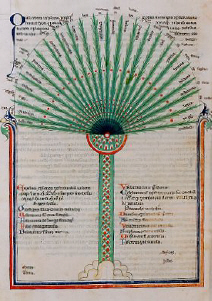5. What then is the veritable nature of Number?
Is it an accompaniment upon each substance, something seen in the things as in a man we see one man, in a being one being and in the total of presentations the total of number?
But how explain the dyad and triad? How comes the total to be unitary and any particular number to be brought under unity? The theory offers a multiplicity of units, and no number is reducible to unity but the simple “one.” It might be suggested that a dyad is that thing – or rather what is observed upon that thing – which has two powers combined, a compound thing related to a unity: or numbers might be what the Pythagoreans seem to hold them in their symbolic system in which Justice, for example, is a Tetrad: but this is rather to add the number, a number of manifold unity like the decad, to the multiplicity of the thing which yet is one thing. Now it is not so that we treat the ten things; we bring them together and apply the figure ten to the several items. Or rather in that case we say ten, but when the several items form a unity we say decad. This would apply in the Intellectual as in the sensible.
But how then can number, observed upon things, rank among Real Beings?
One answer might be that whiteness is similarly observed upon things and yet is real, just as movement is observed upon things and there is still a real existence of movement. But movement is not on a par with number: it is because movement is an entity that unity can be observed upon it. Besides, the kind of real existence thus implied annuls the reality of number, making it no more than an attribute; but that cannot be since an attribute must exist before it can be attributed; it may be inseparable from the subject but still must in itself be something, some entity as whiteness is; to be a predicate it must be that which is to be predicated. Thus if unity is observed in every subject, and “one man” says more than “man’s oneness being different from the manness and common to all things – then this oneness must be something prior to man and to all the rest: only so can the unity come to apply to each and to all: it must therefore be prior also to even movement, prior to Being, since without unity these could not be each one thing: of course what is here meant is not the unity postulated as transcending Being but the unity predicable of the Ideas which constitute each several thing. So too there is a decad prior to the subject in which we affirm it; this prior would be the decad absolute, for certainly the thing in which the decad is observed is not that absolute.
Is this unity, then, connate and coexistent to the Beings? Suppose it coexistent merely as an accidental, like health in man, it still must exist of itself; suppose it present as an element in a compound, there must first exist unity and the unity absolute that can thus enter into composition; moreover if it were compounded with an object brought into being by its agency it would make that object only spuriously a unity; its entry would produce a duality.
But what of the decad? Where lies the need of decad to a thing which, by totalling to that power, is decad already?
The need may be like that of Form to Matter; ten and decad may exist by its virtue; and, once more, the decad must previously exist of its own existence, decad unattached.
